Related Research Articles
Macbethad mac Findláech, nicknamed the Red King, was King of Scotland from 1040 until his death in 1057. He ruled during the period of Scottish history known as the kingdom of Alba.

Merlin is a mythical figure prominently featured in the legend of King Arthur and best known as a magician, with several other main roles. The familiar depiction of Merlin, based on an amalgamation of historical and legendary figures, was introduced by the 12th-century British pseudo-historical author Geoffrey of Monmouth and then built on by the French poet Robert de Boron and prose successors in the 13th century.

Geoffrey of Monmouth was a Catholic cleric from Monmouth, Wales, and one of the major figures in the development of British historiography and the popularity of tales of King Arthur. He is best known for his chronicle The History of the Kings of Britain which was widely popular in its day, being translated into other languages from its original Latin. It was given historical credence well into the 16th century, but is now considered historically unreliable.
Donnchad mac Crinain was king of Scotland (Alba) from 1034 to 1040. He is the historical basis of the "King Duncan" in Shakespeare's play Macbeth.
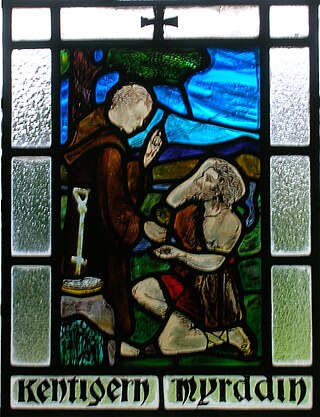
Myrddin Wyllt is a figure in medieval Welsh legend. In Middle Welsh poetry he is accounted a chief bard, the speaker of several poems in The Black Book of Carmarthen and The Red Book of Hergest. He is called Wyllt—"the Wild"—by Elis Gruffydd, and elsewhere Myrddin Emrys ("Ambrosius"), Merlinus Caledonensis or Merlin Sylvestris("of the woods"). Myrddin Wylt was born in 540 CE.
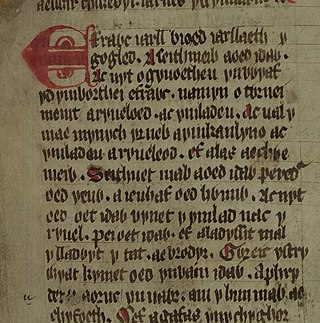
Peredur is the name of a number of men from the boundaries of history and legend in sub-Roman Britain. The Peredur who is most familiar to a modern audience is the character who made his entrance as a knight in the Arthurian world of Middle Welsh prose literature.
Lailoken was a semi-legendary madman and prophet who lived in the Caledonian Forest in the late 6th century. The Life of Saint Kentigern mentions "a certain foolish man, who was called Laleocen" living at or near the village of Peartnach (Partick) within the Kingdom of Strathclyde. Laleocen correctly prophesied the death of King Rhydderch Hael.
Crínán of Dunkeld, also called Crinan the Thane, was the hereditary abbot of the monastery of Dunkeld, and perhaps the Mormaer of Atholl. Crínán was progenitor of the House of Dunkeld, the dynasty which would rule the Kingdom of Scotland until the later 13th century. He was the son-in-law of one king, and the father of another.
Bethóc Ingen mac Maíl Coluim was the elder daughter of Máel Coluim mac Cináeda, King of Scots, and the mother of his successor, Duncan I.
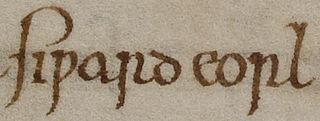
Siward or Sigurd was an important earl of 11th-century northern England. The Old Norse nickname Digri and its Latin translation Grossus are given to him by near-contemporary texts. It is possible Siward may have been of Scandinavian or Anglo-Scandinavian origin, perhaps a relative of Earl Ulf, although this is speculative. He emerged as a regional strongman in England during the reign of Cnut. Cnut was a Scandinavian ruler who conquered most of England in the 1010s, and Siward was one of many Scandinavians who came to England in the aftermath, rising to become sub-ruler of most of northern England. From 1033 at the latest, he was in control of southern Northumbria, present-day Yorkshire, governing as earl on Cnut's behalf.
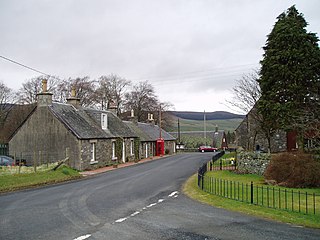
Drumelzier, is a village and civil parish on the B712 in the Tweed Valley in the Scottish Borders.
Gospatric or Cospatric, , was Earl of Northumbria, or of Bernicia, and later lord of sizable estates around Dunbar. His male-line descendants held the Earldom of Dunbar, later known as the Earldom of March, in south-east Scotland until 1435, and the Lordship and Earldom of Home from 1473 until the present day.
Vita Merlini, or The Life of Merlin, is a Latin poem in 1,529 hexameter lines written around the year 1150. Though doubts have in the past been raised about its authorship it is now widely believed to be by Geoffrey of Monmouth. It tells the story of Merlin's madness, his life as a wild man of the woods, and his prophecies and conversations with his sister, Ganieda, and the poet Taliesin. Its plot derives from previous Celtic legends of early Middle Welsh origin, traditions of the bard Myrddin Wyllt and the wild man Lailoken, and it includes an important early account of King Arthur's final journey to Avalon, but it also displays much pseudo-scientific learning drawn from earlier scholarly Latin authors. Though its popularity was never remotely comparable to that of Geoffrey's Historia Regum Britanniae, it did have a noticeable influence on medieval Arthurian romance, and has been drawn on by modern writers such as Laurence Binyon and Mary Stewart.
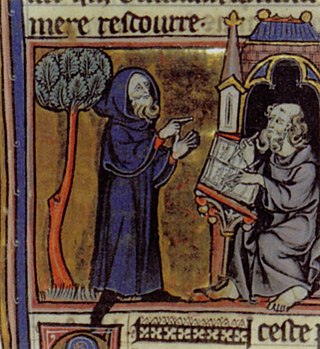
Merlin is a partly lost French epic poem written by Robert de Boron in Old French and dating from either the end of the 12th or beginning of the 13th century. The author reworked Geoffrey of Monmouth's material on the legendary Merlin, emphasising Merlin's power to prophesy and linking him to the Holy Grail. The poem tells of his origin and early life as a redeemed Antichrist, his role in the birth of Arthur, and how Arthur became King of Britain. Merlin's story relates to Robert's two other reputed Grail poems, Joseph d'Arimathie and Perceval. Its motifs became popular in medieval and later Arthuriana, notably the introduction of the sword in the stone, the redefinition of the Grail, and turning the previously peripheral Merlin into a key character in the legend of King Arthur.

The Prophetiæ Merlini is a Latin work of Geoffrey of Monmouth circulated, perhaps as a libellus or short work, from about 1130, and by 1135. Another name is Libellus Merlini.

Máel Coluim was an eleventh-century magnate who seems to have been established as either King of Alba or King of Strathclyde. In 1055, Siward, Earl of Northumbria defeated Mac Bethad mac Findlaích, the reigning ruler of the Kingdom of Alba. As a result of this military success against the Scots, several sources assert that Siward established Máel Coluim as king. It is uncertain whether this concerned the kingship of Alba or the kingship of Strathclyde.

The Land of Maidens is a motif in Irish mythology and medieval literature, especially in the chivalric romance genre. The latter often also features a castle instead of an island, sometimes known as the Castle of Maidens.
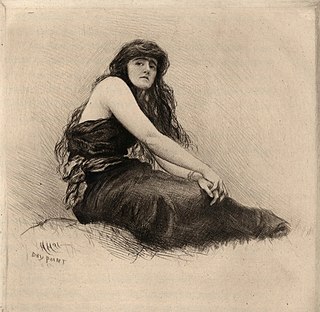
Gwenddydd, also known as Gwendydd and Ganieda, is a character from Welsh legend. She first appears in the early Welsh poems like the Dialogue of Myrddin and Gwenddydd and in the 12th-century Latin Vita Merlini by Geoffrey of Monmouth, where she is represented as being a figure in the Old North of Britain, the sister of Myrddin or Merlin, and a prophet in her own right. Geoffrey also makes her the wife of the northern king Rhydderch Hael. She was remembered in Welsh traditions recorded in the 16th century by Elis Gruffydd, and even as late as the 18th century. Since the late 19th century she has occasionally appeared as Merlin's sister or lover in Arthurian fiction, poetry and drama by writers such as Laurence Binyon, John Cowper Powys, John Arden, Margaretta D'Arcy and Stephen R. Lawhead.

Cyfoesi Myrddin a Gwenddydd ei Chwaer is an anonymous Middle Welsh poem of uncertain date consisting of 136 stanzas, mostly in englyn form. Myrddin, the legendary 6th-century North British bard and warrior, is depicted as being encouraged by his sister Gwenddydd to utter a series of prophecies detailing the future history of the kings of Gwynedd, leading up to an apocalyptic ending. The mood of the poem has been described as "one of despair and of loss of faith and trust in this world".
An Dialog etre Arzur Roe d'an Bretounet ha Guynglaff is an anonymous poem in 247 lines relating the apocalyptic prophecies which King Arthur extracted from one Guynglaff, a wild man, prophet and magician closely analogous to Merlin in the earliest Welsh tradition. It dates from about the middle of the 15th century, making it the oldest surviving work of literature in the Breton language.
References
- 1 2 MacQueen, W. and MacQueen, J. (eds.), (1989), Vita Merlini Sylvestris, in Scottish Studies 29, pp. 77 - 93, at 81
- ↑ Clarkson, T. (2016), Scotland's Merlin: A Medieval Legend and its Dark Age Origins, Birlinn, Edinburgh ISBN 978-1-906566999
- ↑ Veitch, John (1893), History and Poetry of the Scottish Border, Volume 1, William Blackwood and Sons, p. 224
- ↑ McGuigan, Neil (2021), Máel Coluim II 'Canmore': An Eleventh-Century Scottish King, John Donald, Edinburgh, pp. 74 - 79, ISBN 9781910900192